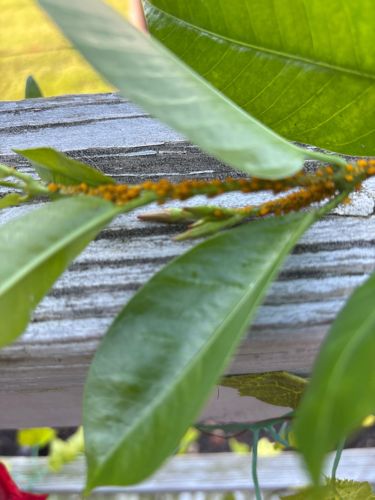Aphids (likely a species of aphid, potentially Oleander Aphid based on color and host)
Scientific Name: Aphididae (Oleander Aphid: Aphis nerii)
Order & Family: Hemiptera, Aphididae
Size: Typically 1-4 mm (0.04-0.16 inches) long

Natural Habitat
Found on a wide variety of plants, especially new growth, stems, and undersides of leaves, in gardens, agricultural fields, and natural environments globally.
Diet & Feeding
Aphids are phytophagous, meaning they feed exclusively on plant sap. They insert their stylets (mouthparts) into the phloem of plants to extract nutrients. This feeding can distort leaves, stunt growth, and transmit plant viruses.
Behavior Patterns
Aphids are typically found in colonies, often densely packed on plant stems and leaves. They reproduce rapidly, often parthenogenetically (without mating), and can have multiple generations in a single season. Many species excrete 'honeydew,' a sugary waste product, which can lead to sooty mold growth. Some species are tended by ants, which protect them from predators in exchange for honeydew.
Risks & Benefits
Aphids pose a significant risk to plants, causing direct damage through feeding (stunting growth, leaf curl, yellowing) and indirect damage by transmitting plant viruses. They are a common pest in gardens and agriculture. On the benefit side, they serve as a food source for many beneficial insects such like ladybugs, lacewings, and hoverfly larvae, which helps in natural pest control. However, their pest status generally outweighs any ecological benefits.
Identified on: 9/26/2025